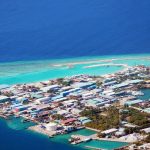Sable Island
For hundreds of years, sailors have been in awe and terrified of Sable Island. The island is located about 110-miles off the coast of Nova Scotia. It is a sliver of, and that juts out of the Atlantic Ocean. It is about 28-miles long, and it gets its name from the material that forms its half-moon shape. Despite its small size and incredible appearance, the island has a disconcerting history.
Morphing
The landmass is made of sand, and it is capable of changing its shape. Each time experts try to map the island; they have a hard time because it is continually morphing. For example, in 2014, a CBC report noted that the sand was disappearing from the west end, but accumulating at the east end. We know that the ocean can erode, causing sand dunes to move. We know that the topography doesn’t always remain consistent, but none are shapeshifting island like Sable Island. The shapeshifting island isn’t the only shocking thing about this place. Over the years, it has caused several ships attempting to sail from Nova Scotia to sink.
Joao Alvares
Not every ship that has attempted the reach the island has suffered a tragic end. In 1520, a Portuguese explorer named Joao Alvares made landfall in this shapeshifting island. He wasn’t the only one to make landfall on the island. His discovery was innocent, but not everyone who attempted to reach the island was doing so for a good reason.
Marquis de la Roche
Quite a few historical figures are said to have gone to Sable Island with sinister plans. One of them was Marquis de la Roche. In 1578, he became the Governor of New France. His territory stretched from Newfoundland to the Hudson Bay and the Gulf of Mexico. Even though his territory stretched so far, he decided to use Sable Island for a sinister reason. He wanted to bring convicts with him to settle in New France, but they didn’t want to go.
The group revolted against the leaders. Because of this, Marquis decided to leave them behind on the barren Sable Island. There were no trees or stone to help them make shelter for themselves. They had to use mud and shipwrecked timber to build their homes. It is believed that many of them lived on the island for 5 to 25 years. Since then, 350 ships are believed to have sunk in the waters around the island.
The Geography
Some people believe that it is the angry spirits of the convicts that are causing the ships to sink. Scientists have a more plausible theory. They think that it is the geography of the island that has been causing fatal shipwrecks. The shape-shifting island is surrounded by sand. This creates sandbars with ridges that build as the waves move back and forth. This carries sand which can be devastating to ships since they are hidden under the waves. When a vessel is moving quickly, they won’t see the sandbar, and they won’t be able to slow down in time or steer clear of the sandbars. By the time the ship’s crew discovers the danger, it is too late.
Further Problems
Sable Island is in the middle of two different flows of water. This makes the conditions that much more dangerous for the sailors in the area. The Labrador Current flows cold water near the island, while the Gulf Stream funnels warm water toward the island. This combination can cause fog to appear in the area very quickly. The fog can envelop the landmass completely, making it impossible to see.
Another Dangerous Problem
The third thing that sailors need to worry about when in the vicinity of the island is the vortex that appears in the area, and pulls vessels right into the island. According to the park manager of Sable Island, Jonathan Sheppard, there are old sailors’ stories about being sucked right into the island. Due to the vortex, these stories are believable.
The Shipwrecks
Because of this trifecta of dangerousness, there have been plenty of shipwrecks. The first reported disaster was an English ship called the Delight, and it sank in 1583. Nearly 200-years later, a boat traveling to Prince Edward Island crashed into Sable Island, and the crew was shipwrecked there for the entire winter.
Protective Measures
Over the years, protective measures have been taken to prevent ships from sinking. There are now two lighthouses on the island, which can prevent wrecks despite the island’s shape-shifting. Despite the lighthouses being built on the island, there was a wreck as recently as 1947. It was a ship called the Manhasset, and it sunk in the dangerous waters.
Surviving On the Island
If you made it to the island without your ship sinking, you wouldn’t find much. There is one tree on the island that was planted in the 1960s, and it has only grown a few feet since. There is very little vegetation. Marram grass which grows on the dunes live on the island, but that’s about it. There is sea life around the island. There are 18 species of sharks that swim in the area. Also, the harbor and grey seals use Sable Island as a breeding ground. Many people wonder why nothing can thrive on the island. Some believe that this mysterious shapeshifting island in the Atlantic Ocean hides a deadly secret. Spirits. Others believe that it is just the location and the dangerous trifecta that has made this such a dangerous and barren island.


